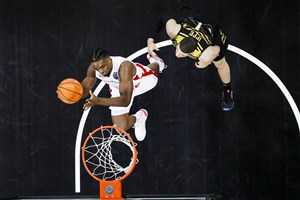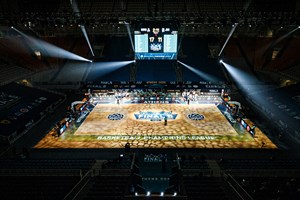
The modern ERA - Nymburk's defense bucks the trend
MADRID (Spain) - Basketball in the Czech Republic ignited in 2019 - not only did the National Team qualify for their first World Cup ever, they also went on to finish 6th, collecting famous victories over powerhouse nations Turkey and Brazil en route. Tomáš Satoranský was unequivocally the pilot of that team, but the engines were powered by the chemistry of six players from the same club team. That club team was ERA Nymburk and the six players were Vojtěch Hruban, Jaromír Bohačík, Martin Kříž, Martin Peterka, Tomáš Vyoral and Pavel Pumprla.
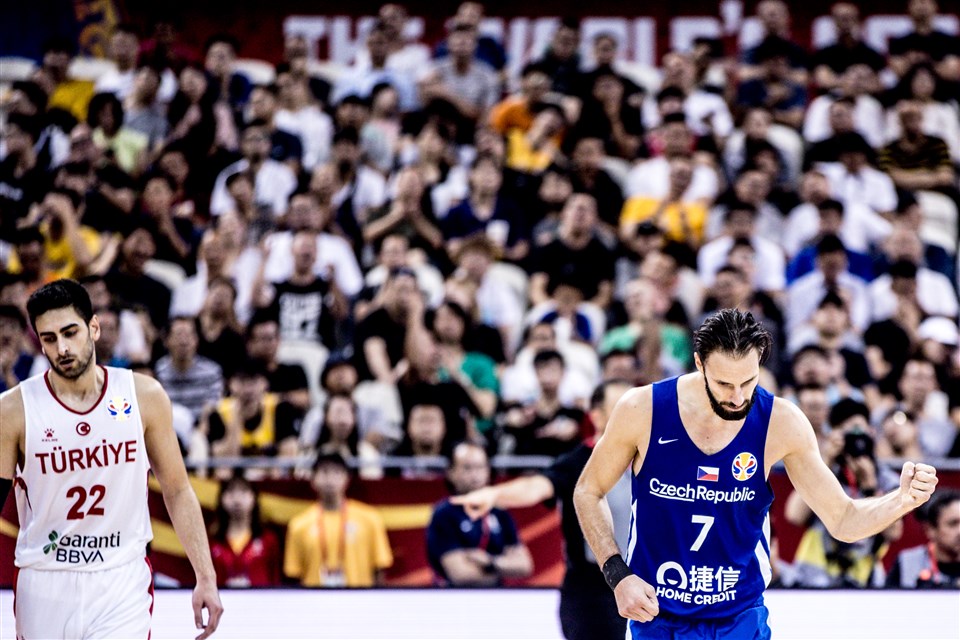 Vojtěch Hruban helping the Czech Republic record one of their most famous victories ever
Vojtěch Hruban helping the Czech Republic record one of their most famous victories ever
The fusion between the Czech National Team and ERA Nymburk on the floor has also translated into a rising passion for the game off the floor for Nymburk. The idea of packed-house games on a Wednesday night in Prague might have seemed make-believe not so long ago - they are a consistent reality these days when Nymburk take the floor for a Basketball Champions League night. Those fans crammed into the Královka Arena have been rewarded by watching the most competitive iteration of their team that the BCL has seen. For the first time in four seasons, Nymburk topped their Regular Season group. They also ended the Regular Season with the best record in the league. This rise into a modern era force was in no small part thanks to coach Oren Amiel's defensive system.
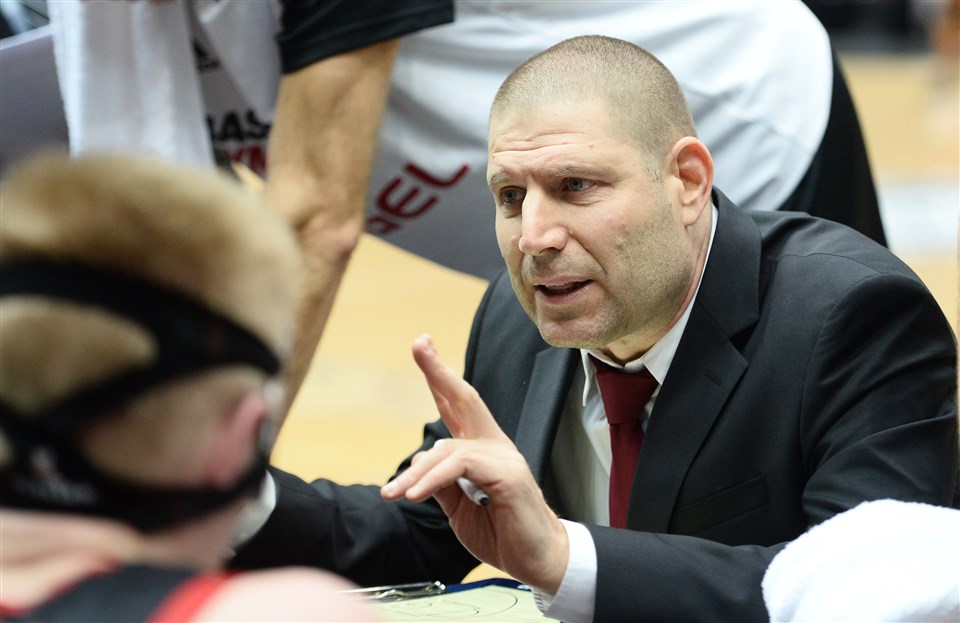
If you have read the recent article on our website about the steady increase in similarities between the BCL and the Houston Rockets' "Moreyball," you will have gained an understanding that the BCL - like every league in the modern era - is observing an ever-increasing rate of points generated from behind the arc. This trend towards offenses attempting more shots from deep is what makes ERA Nymburk's defense so fascinating this season. This year Nymburk have been clearly the best defensive team in the league but they have done that despite conceding the fourth-most attempts from behind the arc. We spoke to head coach Oren Amiel about building his team around the chemistry of his returning National Team stars and also building a defensive system that flies in the face of the league's trend of prioritizing the 3-point shot.
"The biggest strength of this club is the Czech players and for many reasons. We know each other very well (the players and coaching staff). I know their skills, habits, and personalities and they know me, my requirements and standards, and our game style," said coach Amiel.
When a team has an established culture that is built around a core of returning players, it can give them a head start in terms of buy-in. According to coach Amiel, this strength of character and player leadership was vital to Nymburk's success this season,
"The group of guys we had this season allowed us to create solid foundations with strong habits and they had an open mind to accept our ideas. Of course when you have such strong personalities like Petr, Pampi, Vojta, and Boci everybody follows their lead and it makes your job easier."
Coach Amiel also feels that the buy-in gained from the squad following the Czech core brought about clarity and understanding of the plan that enabled an increased effort and collective will.
"I honestly can say that most games we play harder than our opponent and it's based on feeling, 70/30 numbers, and results," he said.
The video below is an excellent example to highlight coach Amiel’s point about playing harder than their opponents. In the fourth quarter of a blowout win, with no real necessity to chase so hard, Booker sprints the court to make an unbelievable defensive play.
The 70/30 numbers that coach Amiel refers to here is a system from Sports Scientist Dan Valency that he and his staff implemented when he took the Head Coach position in 2017. He explained,
"We installed into the program a system called 70/30 created by Dan Valency. This method measures and analyzes Effort and Activity, and gives us another view of how to evaluate individuals and team performance."
The basis of the system is around separating the actions of a player and a team into 'Red' actions from the soul or will, and 'Blue' skill or ego actions. The premise is to measure performance based on a metric around 70% of the Red and 30% of the blue. That is obviously an over-simplification but the system has clearly been integral to the program. Coach Amiel expanded on the recruitment process that has seen the likes of Zach Hankins, Deishaun Booker, and Hayden Dalton all take significant career-steps. For Hankins and Booker, this has been their rookie campaigns in Europe, and Dalton has made the jump from the Danish league and FIBA Europe Cup look seamless.
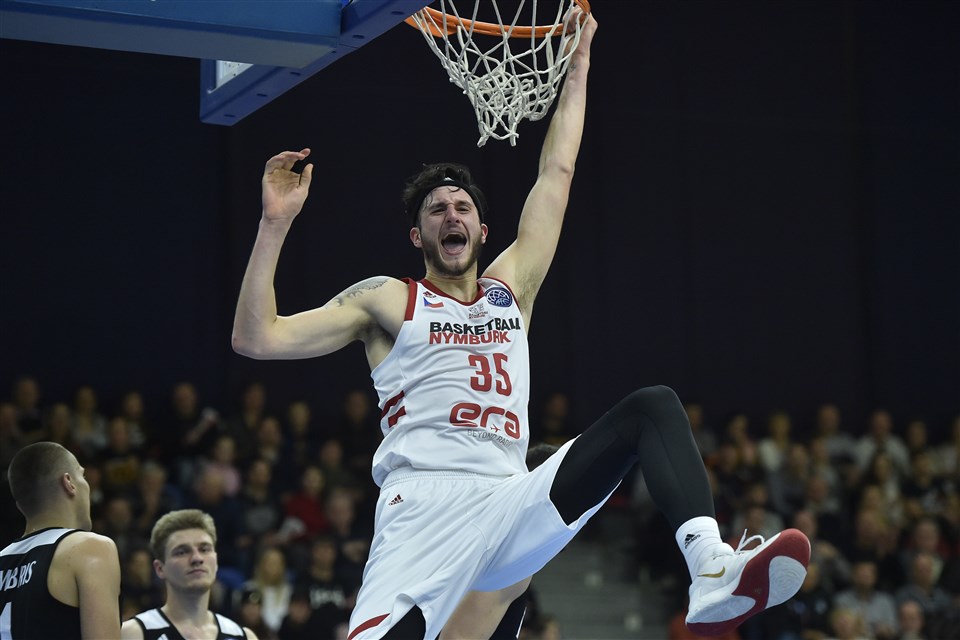 Zach Hankins has been dominant for ERA Nymburk
Zach Hankins has been dominant for ERA Nymburk
"When we are searching for players we know exactly what we are looking for, but it doesn't mean we always have success to find the best or the right fit. First we look for hungry players that we think have the upside to grow. We need players who want to prove something but are also willing to listen," said coach Amiel.
He then expanded on the process,
"In general, we're setting three requirements for each position and we then set priorities. We know we can't have a player who can do it all, so we want to be as precise as possible in order to get the player who will first fulfill our priorities and also have the potential to become great in them. If there is someone we think could answer those priorities, we also evaluate him with 70/30 so we know he has the character and the habits of effort and activity."
The effort and activity that coach Amiel references so consistently leads coherently into the defensive system that has been so fruitful for Nymburk this year. No team in the BCL Regular Season defended more possessions by starting with full-court pressure. For coach Amiel, the first step to build a pressing team was to make offensive rebounding a priority.
"We put rebounding as our first priority, with special attention to offensive rebounding. This is how we start our defensive full-court pressure - that was also something we developed," he stated.
Looking through the film, Nymburk’s philosophy on the offensive glass is clear. On every jump-shot, they crash from both corners and at a minimum send another body to the center of the paint, often two bodies (unless there is a leak-out runner to be tracked). In the first clip of the video below you see how they send both corners and the paint player forming the triangle. Even when they don’t get the offensive rebound, two players trap the ball just long enough to slow a quick outlet and transition. They then sprint back and double the early post entry. In the following clips you see the triangle of rebounders (in the third clip all four rebounders). You also see how they contest with one arm outstretched, often preferring to tip the ball to a teammate than attempting the catch.
From the structure of disciplined offensive rebounding, Nymburk then builds their defensive system around the phases of the possession. Amiel explained it that it's more than just transition and half-court defense,
"In general we split our defense into three parts; full-court pressure, the first part of the half-court possession, and the end of the half-court possession. Every part has its targets and the idea of how to reach it. Of course there are a lot of details but in general, going back to 70/30, we want to exhaust the opponents to the point they shoot when they're tired and with less confidence, then even when they find some good looks we believe that percentages will drop."
This is where we can really look at what makes Nymburk's defense different and in order to highlight how different it is, we need to go a little deeper - starting with the chart below. What you are looking at is every team in the BCL through the lens of Defensive Rating (DRtg) and 3 point attempts (3PA) allowed. The better the number for a teams' DRtg, the lower their club crest appears in the chart, the further to the left you see the crest, the fewer 3PA's allowed. The black line is the trend line which is exploring the correlation between the two. Generally speaking the steeper the angle of the line, the stronger the relationship.
In a league where teams are attempting more and more shots from three, you would expect that the teams that allow the fewest might be more efficient defensively. What this table shows us, is that it isn't necessarily the case. There is a slope to show some correlation but if we are looking for a statistically significant relationship, or to prove that the relationship between DRtg and 3PA's allowed is anything other than random, we need to pay attention to the P-value on that trend line. If you hover your mouse over the trend line (click it on your mobile device), you will see the P-value shows as 0.17.
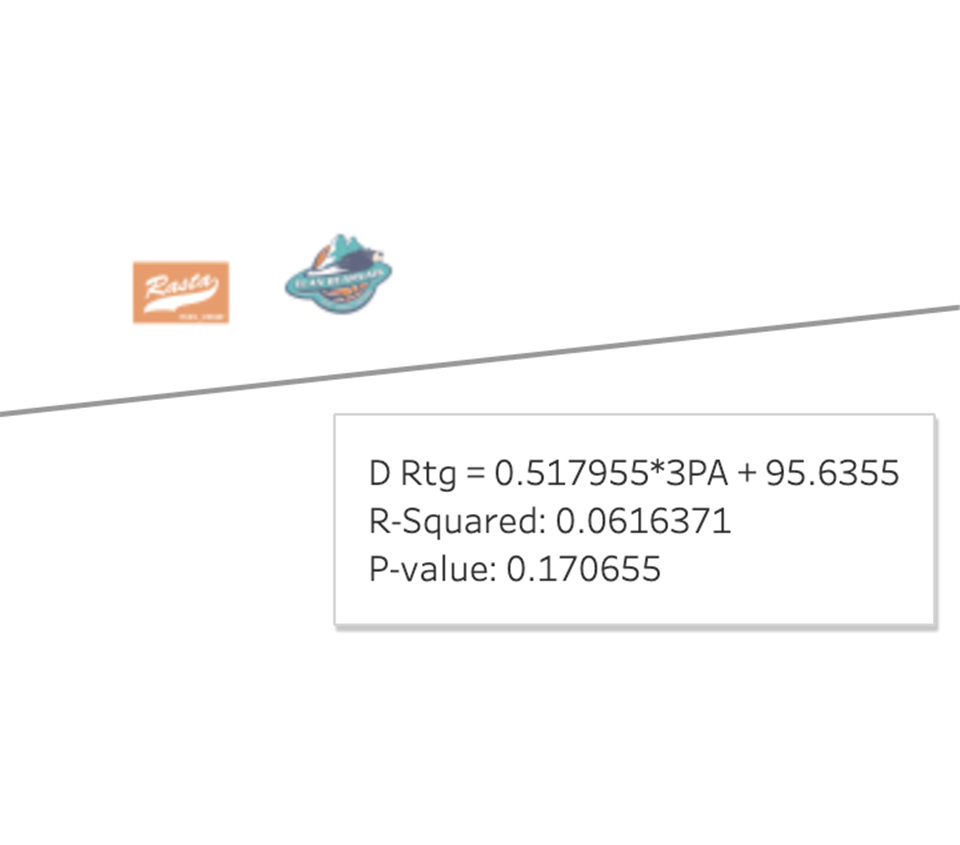
In order to reject the hypothesis that the relationship between the two is merely random, we need that P-value to be below 0.05 (the lower the number the more significant the relationship). So clearly this chart shows that allowing fewer 3PA’s doesn't have a significant relationship with a better DRtg for BCL clubs this season. However, what that chart also shows you is that ERA Nymburk is a massive outlier - as we said earlier, they are clearly the holders of the best DRtg in the BCL (95.5 per 100) but also concede the fourth-most 3PA’s (28 per game). What happens if we remove them as an outlier case? If you click the team filter in the top left of the chart and un-Czech the box (sorry, couldn't resist it) we see a dramatic change in that P-value.
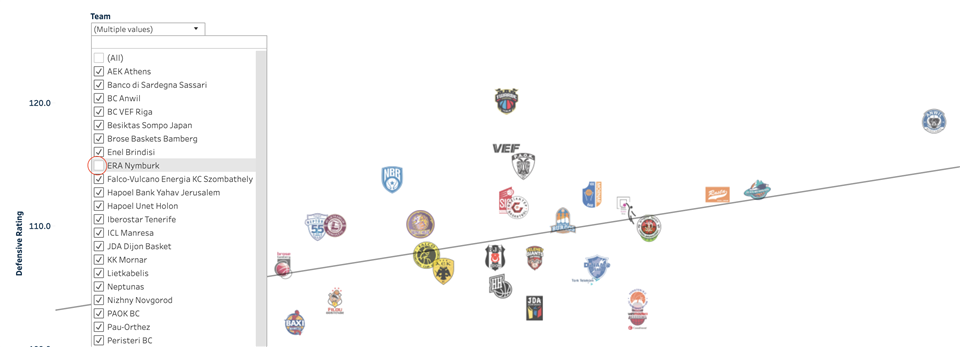
Minus Oren Amiel's squad, the P-value now reads as 0.03. So, effectively, for every team in the BCL not called ERA Nymburk, less 3PA's conceded is statistically significant with a better DRtg - very much in fitting with the trend of the modern era. This is a stat that becomes even more interesting when you consider that Nymburk don't rank in the top five for Steal Percentage, Defensive Rebounding Percentage, or Opponent Turnover Percentage. Their league-best defense is almost completely driven by their ability to reduce their opponent's shooting percentages, in fact their opponents shoot an Effective Field Goal Percentage of just 46 percent against them (the lowest in the BCL). This has been a direct result of controlling the types of shots they allow - in this case more 3PA's. They have completely bucked the trend and converted the league's trend towards shooting more three's, into their advantage on defense.
For Oren Amiel, this is about forcing teams' low volume shooters to take contested jump-shots, often after an exhaustive possession against Nymburk's full-court pressure.
"The main idea is to take the opponent out of his comfort zone and force him to play with a high pulse. It forces more mistakes, more shots under fatigue, and even more shots for players that usually shoot less. We can use some frontcourt traps or fake traps and sometimes we just put ball pressure."
We covered the way that Nymburk benefit from their offensive rebounding and coach Amiel spoke about the way crashing the glass puts them in position to start the pressure defense, let's look at what that translates into with a very typical defensive possession for Nymburk.
Watch the clip below, notice both corners again attacked the glass but as the shot falls, Booker and Dalton were in prime position to start the pressure. Although Booker was aggressive with his hands, the intent is more about slowing any transition up the court. By the time Booker had switched back onto guarding Nizhny's Point Guard and the Russians had managed to enter a halfcourt offense, there were 13 seconds left on the clock - by coach Amiel's definition, this means that Nymburk had successfully negotiated the first two parts of the possession without any threat from Nizhny's offense. The next threat came from a dribble handoff into an angle pick-and-roll but Hankins footspeed meant that Nymburk were comfortable switching and then as the ball went into the corner, Hankins was able to use his length and stunt at the ball to slow the flow even more. The result is a heavily contested 3-point attempt as the shot clock winds down.
Again in this next clip, we see the same basic man to man pressure vs Peristeri. Roko Rogic (#32) completely blows up the "Veer" pin down forcing Peristeri into the next action. This time, instead of switching (#4) Petr Benda drops to allow Booker time to recover over the pick-and-roll, his positioning is excellent and he can play his man and Booker's. Nymburk guard the pick-and-roll 2v2, which means no defensive rotations and no open threes. The outcome is (#18) Karampelas (a 29% 3-point shooter) forcing up a contested shot with 1.2 seconds on the clock, after having the ball in his hands most of the possession.
The other pressure defense you regularly see from Nymburk is a 2-2-1 zone press. The clip below gives you a very clear visual of how they lineup and what the end game is. The primary purpose is to control the first two sections of the possession and slow the offense down. The extra benefits are to keep the ball out of the middle of the floor and try and take the offense out of alignment. When you watch modern basketball, you will regularly see teams play through "Flow "and "Delay" offenses where the ball is thrown to a big man in the middle of the floor, and teams look to get into screening and pick-and-roll actions on either side of the floor.
With Nymburk employing this kind of press, it makes it very challenging for a team to get the ball into the middle of the floor early in the offense. Also, take note of how they executed this defense. Nymburk were switching again in this clip, the physical communication cues are clear and as soon as the ball entered the post or the paint, they were showing traps (as coach Amiel mentioned) and digging and stunting down to force the ball out again, or get deflections.
The outcome was again, a heavily contested 3-pointer and even after giving up the offensive rebound, as soon as the ball gets inside, they are immediately attacking the ball like wasps defending a nest.
This next clip we see the 2-2-1 press again. This time Nymburk drop back into a clear zone. The outcome is again, a late, contested three. Notice that it's Nymburks 6'11" (2.11m) center sprinting out to contest the shot. When you see all five players committed to the system and winning the effort battles like this, it becomes easier to understand how Nymburk and coach Amiel built the best defense in the BCL.
It remains to be seen how quickly coach Amiel and Nymburk will be able to restart the system when basketball returns and if they can be the same defensive antidote to modern basketball over a longer period next season. What is clear is that the sample size of this season is enough to show us that there is more than one way to solve every problem. It seems inevitable that the trend towards more and more 3PA's is unlikely to slow down soon.
It will, however, be interesting to see if more teams elect to study the way Nymburk played defense this season and how that might impact the trend moving forward.
The Basketball Champions League's columnists write on a wide range of topics relating to basketball that are of interest to them. The opinions they express are their own and in no way reflect those of FIBA or the Basketball Champions League.
The Basketball Champions League takes no responsibility and gives no guarantees, warranties or representations, implied or otherwise, for the content or accuracy of the content and opinion expressed in the above article.





